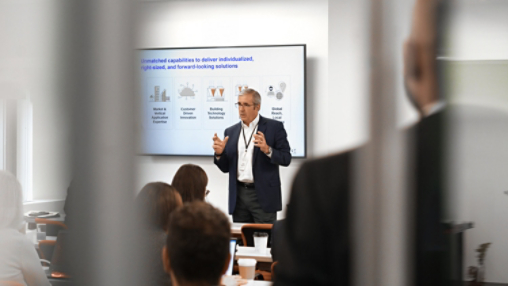A good test of any company’s commitment to sustainability is the agenda for the meeting of its Board of Directors, a carefully curated list of the most important topics for the company. For Trane Technologies, sustainability is not an item (or several items) on the list. It’s the whole list.
The Executive Leadership Team and Board of Directors of Trane Technologies view climate change not as a problem to be managed through compliance, but as the defining issue of our day. We see climate change as a disruptive platform for innovation that has the potential to stimulate a significant wave of growth and create a more sustainable world. As a company specializing in heating and cooling buildings and refrigerated transport, connecting strategy to sustainability is not only our responsibility, but our core purpose and a strategic opportunity for our business.
Viewing ESG as a strategic growth platform
We know we are not in the majority. Many companies still view climate change and its associated impacts as problems to be monitored and managed. They review their core businesses and approve strategies that reduce negative ESG impacts. They react to important indicators rather than develop a deep understanding of the magnitude and scale of the business risks posed by ESG issues.
A board’s ultimate purpose is ensuring the long-term viability and success of a company. Directors should consider whether they are thinking about ESG the right way. To maximize long-term value for shareholders and create value for society, how should the board reflect the growing importance of ESG in its oversight?
Working alongside external experts, like Gib Hedstrom, founder of ESG Navigator, Trane Technologies has been on this journey for many years. We began to integrate ESG performance into our business in 2010 when we established the Center for Energy Efficiency and Sustainability and launched an internal Diversity & Inclusion Council. Shortly thereafter, we issued our first climate materiality assessment and sustainability addendum to the annual report.
Accelerating through strategic commitments
It was during that stage of transformation that our approach shifted, moving from an assessment of risk and compliance to be managed - to building a platform of growth opportunities tied to United Nations Sustainable Development Goals and global megatrends changing the business landscape. Today there is no separate view of ESG and the company’s strategy. Sustainability is the strategy.
In 2020, as Trane Technologies, a pure-play climate company, we launched the Gigaton Challenge, a first-of-its-kind, SBTi-validated, business-to-business commitment to reduce customers’ carbon emissions by 1 billion metric tons. In 2022, the company’s Net-Zero by 2050 targets were among the first in the world to receive SBTi confirmation, another demonstration of ESG leadership.





















